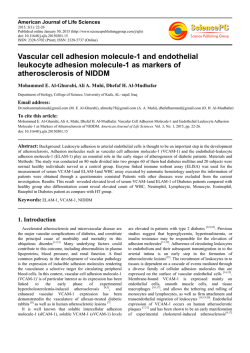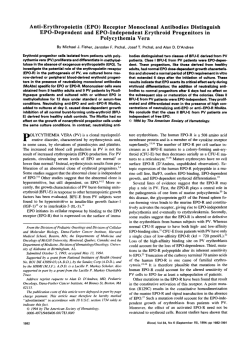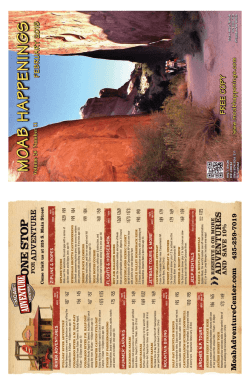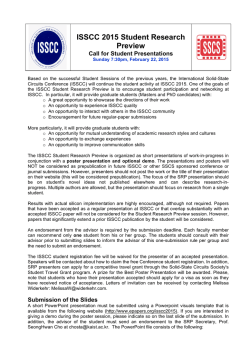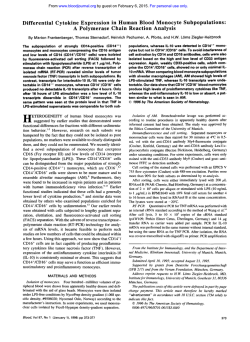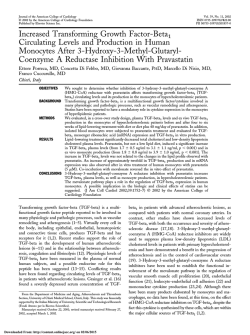
Human Monocytes Bind to Two Cytokine-Induced Adhesive
From www.bloodjournal.org by guest on February 6, 2015. For personal use only. Human Monocytes Bind to Two Cytokine-Induced Adhesive Ligands on Cultured Human Endothelial Cells: Endothelial-Leukocyte Adhesion Molecule-1 and Vascular Cell Adhesion Molecule-1 By T. Carlos, N. Kovach, 6.Schwartz, M. Rosa, B. Newrnan, E. Wayner, C. Benjamin, L. Osborn, R. Lobb, and J. Harlan Vascular cell adhesion molecule-1 (VCAM-1) and endothelialleukocyte adhesion molecule-1 (ELAM-I) are adhesive proteins induced on endothelium by cytokines. We examined the contribution of these adhesive proteins to human peripheral blood monocyte adherence to endothelium using transfected Chinese hamster ovary (CHO) cells stably expressing these proteins and monoclonal antibodies (MoAbs) to ELAM-I, VCAM-1, or CD49d/CD29 (VLA-4). the leukocyte receptor for VCAM-1. Monocytes bound to CHO cells transfected with cDNA of ELAM-1 or VCAM-1. Binding to ELAM-1 was inhibited by MoAb to ELAM-1 and binding to VCAM-1 was inhibited by MoAb to VCAM-1 or the a-chain of very late activation antigen-4 ( V U - 4 ) (CD49d). Additive inhibition of adherence to unstimulated human umbilical vein endothelium (HUVE) was observed when monocyteswere pretreated with both MoAb to CD49d and MoAb to CD18, the common @-chainof the leukocyte p2 integrin receptors. Adherence of monocytes to HUVE stimulated by recombinant human tumor necrosis factor-a was not reduced by MoAbs to CD18, CD49d. or ELAM-1 when used singly, but combinations of these MoAbs produced significant inhibition. We conclude that multiple receptor-ligand systems are involved in monocyte adherence to endothelium. 0 1991 by The American Society of Hematology. T studies have suggested that monocytes also bind to VCAM1" but the binding of monocytes to ELAM-1 has been difficult to demonstrate clearly.'-' In this report we demonstrate that human monocytes adhere to ELAM-1 and VCAM-1 using Chinese hamster ovary (CHO) cells that have been transfected with cDNA of ELAM-1 or VCAM-1 and are stably expressing these adhesive proteins. We show that this binding is inhibited by monoclonal antibodies (MoAbs) that are specific for ELAM-1, VCAM-1, or the leukocyte receptor for VCAM-1, very late activation antigen-4 (VLA-4, CD49d/CD29).'33'4 Finally, we demonstrate that these endothelial cell ligands are involved in the adherence of human monocytes to human umbilical vein endothelium (HUVE). HE SEQUENCE OF EVENTS leading to monocyte emigration in response to extravascular inflammatory stimuli can be summarized as follows. Signals are generated at the inflammatory site that activate the circulating monocyte and the adjacent endothelium. As a consequence of activation, the circulating monocytes adhere to the endothelium, migrate along the endothelial surface, diapedese, and finally emigrate through subendothelial matrix to participate in the inflammatory reaction.' Neutrophils are initially the predominant leukocyte at inflammatory sites with the peak of emigration occurring within the first several hours after the onset of inflammation.* However, within 12 to 24 hours mononuclear phagocytes become the most abundant cell in the inflammatory The different kinetics of emigration and subsequent accumulation in tissue of neutrophils and monocytes may be explained in part by differences in expression or configuration of adhesion proteins on the phagocyte or the endothelium. Endothelial-leukocyte adhesion molecule-1 (ELAM-1) and vascular cell adhesion molecule-1 (VCAM-1) are surface proteins that are induced on endothelial cells and are involved in leukocyte adhesion. Neutrophils, but not peripheral blood lymphocytes (PBL), have been reported to bind to ELAM-l.'-9 Conversely, VCAM-1 has been shown to bind PBL, but not neutrophils.'0," Preliminary From the Department of Medicine (Hematology), University of Washington, Seattle, WA; Biogen, Inc, Cambridge,MA; and Oncogen, Seattle, WA. Submitted May 14,1990; accepted January 11, 1991. Supported by US Public Health Services Grant HL 18645. T.C. is the recipient of a Clinician-ScientistAward from the American Heart Association. J.H. is the recipient of an Established Investigator Award from the American Heart Association. Address reprint requests to Timothy Carlos, MD, Division of Hematology, ZA-34, Harborview Medical Center, 325 Ninth Ave, Seattle, WA 98104. The publication costs of this article were defrayed in part by page charge payment. This article must therefore be hereby marked "advertisement" in accordance with 18 U.S.C. section I734 solely to indicate this fact. 0 1991 by The American Society of Hematology. 0006-4971191/7710-0010$3.00i0 2266 MATERIALS AND METHODS Generation of CHO cell lines that stably express ELAM-I and VCAM-I. The animal cell expression vectors pBG341JOD.ELAM and .VCAM were constructed as follows: vector pBG312" was modified by insertion of a Notl site into the polylinker sequence. The resulting plasmid, pBG341, was cleaved by Notl and Aat2. The smaller of the two fragments was ligated to the larger of the two fragments generated by Notl and Aat2 cleavage of vector pJOD-S.l6 The resulting vector, pBG341JOD, contains an expression cassette for the dihydrofolate reductase cDNA gene'' and a unique Notl site downstream from the adenovirus major late promoter. The cDNA sequences for either ELAM-1' or for VCAM-1" were inserted into the vector Notl site to generate the animal cell expression vectors pBG341JOD.ELAM and .VCAM, respectively. To generate cell lines stably expressing ELAM-1 and VCAM-1, CHO-dihydrofolate reductase folato (CHO-DHFR-) cells18were electroporated with 200 pg pBG341JOD.ELAM or .VCAM as described.16 Before electroporation the plasmid was linearized using Aat2. Following transfection the cells were cultured in selective medium (minimal essential medium [MEM] a minus; GIBCO, Grand Island, NY) lacking ribonucleosides and deoxynucleotides, supplemented with 200 nmol/L methotrexate, 4 mmol/L glutamine, and 10% dialysed fetal bovine serum (FBS) to select for methotrexate-resistant cells. Individual colonies were picked, plated into 96-well cluster plates, and grown to confluence. Clones expressing sufficient ELAM-1 or VCAM-1 to bind HL60 cells or Ramos cells, respectively, were detected by adhesion assay as described.' CHO cells expressing ELAM-1, but not control CHO cells, bind Blood, Vol77, No 10 (May 15), 1991: pp 2266-2271 From www.bloodjournal.org by guest on February 6, 2015. For personal use only. 2267 HUMAN MONOCYTES BIND TO VCAM-1 AND ELAM-1 the ELAM-1-specific MoAb BBll and MoAb BBll immunoprecipitates a protein of about 130 Kd from CHO.ELAM cell lines." MoAb BB11, but not MoAb 4B9, binds to CHO.ELAM-1 while MoAb 4B9, but not MoAb BB11, binds CHO.VCAM-1" (T. Carlos, unpublished observation, March, 1990). MoAb 4B9 immunoprecipitates a protein of about 100 Kd from CHO.VCAM-1 but not control CHO." Untransfected CHO cells were maintained in MEM a medium supplemented with 4 m m o m glutamine and 10% FBS. Transfected CHO cells (ELAM-1 and VCAM-1) were maintained in MEM a-minus medium supplemented with 4 mmol/L glutamine, 500 nmol/L methotrexate, and 10% FBS. Nonadherent cells. PB monocytes were purified from heparinized whole blood by the method of Recalde?' Preparations were greater than 85% pure monocytes as determined by morphology, nonspecific esterase staining, and reactivity with a CD14 MoAb on fluorescence-activated cell sorter (FACS). The leukemic cell lines, HL60 and Molt 4, were obtained from the American Type Culture Collection (Rockville, MD) and were maintained in MEM (Flow Labs, McLean, VA) supplemented with 10% Cellect fetal calf serum (FCS; Flow Labs). Leukocytes were labeled with "Cr as described" and were resuspended in RPMI medium (M.A. Bioproducts, Walkersville, MD). Cell culture. HUVE were harvested by collagenase treatment of vessels as previously published?' Cells were maintained in RPMI 1640 medium supplemented with 10% adult bovine serum (Hyclone Sterile Systems, Logan, UT), 10% normal calf serum (NCS; Armour Pharmaceutical Co, Kanakee, IL), heparin (90 &mL; Sigma Chemical Co, St Louis, MO), and endothelial growth factor (50 p,g/mL) as described by Thorton et al." Endothelial growth factor was prepared from bovine hypothalamus as described by Maciag et al.= MoAbs. MoAb 4B9 is a murine IgG, that recognizes a 100-Kd antigen on cytokine-activated endothelium. MoAb 4B9 binds to COS cells transfected with VCAM-1 cDNA9 and inhibits PBL adherence to cytokine-stimulated HUVE." MoAb 60.3, a murine IgG,, that recognizes the common P-subunit of the CDlUCD18 complex," and MoAb 60.5, a murine IgG, that recognizes class I HLA framework antigen, were provided by Dr Patrick Beatty, Fred Hutchinson Cancer Research Center, Seattle, WA. MoAb P4C2 is a murine IgG, that recognizes an epitope on the a-chain polypeptide (CD49d) of VLA-4 (CD49diCD29):' MoAb P4C2 does not recognize CHO cells or HUVE as determined by enzyme-linked immunosorbent assay (ELISA). MoAb BBll is a murine IgG, that binds to an epitope on ELAM-1.I9 Anti-Leu-M3 (CD14) was purchased from Becton Dickinson Immunocytometry Systems (Mountain View, CA). Adherence assay. CHO cells were plated onto gelatin-coated 48-well tissue culture plates (Costar Corp, Cambridge, MA) and allowed to reach confluence. The medium was decanted and the wells were washed twice with RPMI containing 2% NCS (RPMI/ NCS). Subsequently, 0.2 mL of control medium (RPMINCS) or medium containing MoAbs BB11,4B9, or P4C2 was added to the monolayer 30 minutes before assay. MoAb P4C2 does not bind to either CHO or HUVE by ELISA assay,I4but binds to monocytes by FACS analysis. Untreated leukocytes or leukocytes that were pretreated for 30 minutes with MoAb 60.3 (40 p,g/mL) were added to each well. Experiments involving monocyte adherence to HUVE were performed in a similar manner. For these experiments, some wells of the 48-well plates were pretreated with 10 ng/mL recombinant human tumor necrosis factor-a (rhTNF-a; Biogen Inc, Cambridge, MA) for 4 hours. Following 30 minutes of incubation at 37"C, nonadherent cells were discarded and the wells were washed once with 0.5 mL phosphate-buffered saline (PBS). Adherent cells were lysed with 1N NH,OH and the lysate was counted in a gamma spectrophotometer. Percent adherence was calculated by the formula: % adherence = "Cr cpm in lysate x 100 total 5'Cr cpm added Statistics. Levels of statistical significance were calculated by paired t-test using Statview (Brainpower, Inc, Calabasas, CA). RESULTS Monocytes bind to ELAM-l-tramfected CHO cells. The adherence of the leukemic cell line HL60 to control CHO cells or CHO cells stably expressing ELAM-1 was examined in three separate experiments (Fig 1A). The adherence of HL60 to control CHO was moderate (33% f 5%) and was not reduced by MoAb 60.3 (28% ? 9%), MoAb BBll (31% 2 8%), MoAb P4C2 (27% f 6%), or MoAb 4B9 (31% f 6%). The adherence of HL60 to ELAM-1transfected CHO was 89% f 2%. MoAb BBll completely blocked the binding of HL60 cells to levels observed in control CHO (26% 2 4%, P < .001). MoAb 60.3, MoAb P4C2, and MoAb 4B9 did not significantly inhibit monocyte .. .I* Treatmentof HL60: CHO: - 60.3 - - - - loorB Q, - - 489 8811 P4C2 60.3 60.3 60.3 60.3+ P4C2 - - 489 BBll - T T 80 V C 60 Q, c 2 is 40 20 Treatmentof monocytes : CHO: - 60.3 - - - - - - P4C2 60.3 60.360.3 60.3+ P4C2 489 8811 - 489 8811 - - Fig 1. Inhibition of HL60 (A) and blood-derived human monocyte (B) binding to CHO cells stably expressing ELAM-1. "Cr-labeled HL-60 leukemic cells or monocytes were incubated in control medium (RPMI) or medium containing MoAb 60.3 (40 pg/mL) for 30 minutes. Leukocytes were then added to 48-well plates containing untransfected ( 0 ) or ELAM-1-transfected [D) CHO cells that had been pretreated for 30 minutes with control medium (RPMI/P%NCS) or control medium containing anti-VCAM-1 MoAb, 489 (20 pg/mL), CD49d P4C2 (1:lo0 dilution of hybridoma supernatant), or antiELAM-1 MoAb BE11 (20 pg/mL). Values represent means ? SEM of three experiments with triplicate wells in each experiment. (§P < .01 Y control CHO. *P < .01 Y control, **P < .01 v MoAb 60.3-control CHO, tP < .01Y ELAM-1/CHO, ttP < .01 Y MoAb 60.3-ELAM-l/CHO.) From www.bloodjournal.org by guest on February 6, 2015. For personal use only. 2268 CARLOS ET AL § W T u 30 C z 2 2 is? 20 IO 0 Treoimentof Molt-4 - 603 - - - CHO: - - - 489 eeii B ~ 4 ~ 2 6 06 033 6 0 3 6 0 3 + P4C2 - - 489 mi - 9 60 s 0 Treatment of monocyies: CHO: - 603 - - - - - - 489 mi P4C2603 6 0 3 6 0 3 6 0 3 + P4C2 - 489 eeii - Fig 2. Inhibition of Molt-4 (A) and blood-derived human monocyte (6) binding t o CHO cells stably expressing VCAM-1. "Cr-labeled Molt-4 leukemic cells or monocytes were incubated in control medium (RPMI) or medium containing MoAb 60.3 (40 pg/mL) for 30 minutes. Leukocytes were then added t o 48-well plates containing untransfected ( 0 )or VCAM-1-transfected (D)CHO cells that had been pretreated for 30 minutes with control medium (RPMI/P%NCS) or control medium containing anti-VCAM-1 MoAb 489 (20 pg/mL), CD49d P4C2 (1:100 dilution of hybridoma supernatant), or antiELAM-1 MoAb B B l l (20 pg/mL). Values represent means 2 SEM of three experiments with triplicate wells in each experiment. (§P< .01 v control CHO, *P < .01 v control CHO, **P < .05 v VCAM-l/CHO, tP < .01 vVCAM-l/CHO, ttP < .01 v MoAb 60.3-VCAM-l/CHO.) Molt-4 cells to control CHO was low (1.5% f 0.3%). The adherence of Molt4 cells to CHO cells that stably express VCAM-1 was significantly higher (26% f 6%). MoAbs 4B9 or P4C2 completely inhibited this binding ( < 1%) while the anti-ELAM-1 MoAb BBll was without significant effect (19% f 4%). The binding of monocytes to CHO cells that had been transfected with VCAM-1 cDNA was also examined in a series of experiments (Fig 2B). The binding of MoAb 60.3-pretreated monocytes to VCAM-1 CHO cells was 49% 5%. The anti-ELAM-1 MoAb BBll did not reduce this binding (50% f 7%). The CD49d MoAb P4C2 and the anti-VCAM-1 MoAb 4B9 significantly inhibited the adherence of MoAb 60.3-pretreated monocytes to VCAM-1-transfected CHO cells (9% 2 2% and 19% f 2%, respectively; P < .05). The combination of MoAb P4C2 and MoAb 4B9 produced no greater inhibition of monocyte binding than that observed with MoAb P4C2 alone (data not shown). Monocyte adherence to unstimulated or rh TNF-a-stimulated HUVE. The binding of monocytes to untreated HUVE or HUVE that were stimulated with rhTNF-a for 4 hours was examined (Fig 3). Because the CD49d MoAb was more effective than the anti-VCAM-1 MoAb in blocking monocyte binding to VCAM-1-transfected CHO cells (Fig 2B), MoAb P4C2 rather than MoAb 4B9 was used to inhibit monocyte binding to VCAM-1 expressed on HUVE. Monocyte adherence to unstimulated HUVE was 57% 2 -I A * binding to ELAM-1-transfected CHO cells (92% 9%, 84% f 4%, and 88% f 4%, respectively). The binding of monocytes to control CHO cells was high (50% f 17%), but was nearly abolished by the CD18 MoAb 60.3 (4% f 3%, mean f SE of three experiments). Using MoAbs specific for C D l l a and CDllb, binding to CHO cells was found to be mediated by CDllaKD18 (data not shown). To detect specific binding to ELAM-1 or VCAM-1, monocytes were pretreated with the CD18 MoAb 60.3 in subsequent experiments. The binding of MoAb 60.3-pretreated monocytes to ELAM-1-transfected CHO cells was 41% 2 6% (Fig 1B). Preincubation of ELAM-1-transfected CHO cells with the anti-ELAM-1 MoAb BBll reduced binding of MoAb 60.3-pretreated monocytes to 8% 4% (P < .01). No effect was observed when MoAb 60.3-pretreated monocytes were added to ELAM-1-transfected CHO cells that had been were preincubated with the CD49d MoAb P4C2 or the anti-VCAM-1 MoAb 4B9 (32% f 9% and 39% 2 8% binding, respectively). Monocytes bind to VCAM-1-transfected CHO cells. The binding of the Molt-4 leukemic cell line to control CHO cells and to CHO cells that stably express the adhesive protein VCAM-1 was examined (Fig 2A). The binding of * \ Y BO-. Treatmentof monocytes - 603 P4C2 - 603 + 603 P4C2 P4C2 HUVE: - - mi - 603 + P4C2 m i 1 BBI~ eeii Fig 3. Inhibition of human blood-derived monocyte binding t o unstimulated (A) or rhTNF-a-stimulated HUVE (B). *'Cr-labeled monocytes were incubated in control medium (RPMI) or control medium containing the CD18 MoAb, 60.3 (40 pg/mL), for 30 minutes. Labeled monocytes were then added t o 48-well plates containing confluent HUVE that had either been untreated (A) or pretreated for 4 hours with rhTNF-a (10 ng/mL) (6). Triplicate wells of the HUVE plate were pretreated for 30 minutes with control medium (RPMI/P%NCS) or with control medium containing the anti-ELAM-1 MoAb B B l l (20 pg/mL), or the CD49d MoAb P4C2 (1:lOO dilution of hybridoma supernatant). Values represent means 2 SEM of nine experiments. (*P< .01 MoAb 60.3 v control, tP < . O l MoAbs 60.3 and P4C2, or MoAbs P4C2 and B B l l v MoAb 60.3 alone, §P < .01 MoAbs 60.3, P4C2, and B B l l v MoAbs 60.3 and P4C2.) From www.bloodjournal.org by guest on February 6, 2015. For personal use only. HUMAN MONOCYTES BIND TO VCAM-1 AND ELAM-1 3% and was significantly reduced by the pretreatment of monocytes with the CD18 MoAb 60.3 (37% 3%, P < .Ol). While the CD49d MoAb P4C2 alone did not significantly inhibit monocyte adherence to unstimulated HUVE (49% f 2%), a statistically significant additive inhibitory effect was seen when MoAb P4C2 was used in conjunction with MoAb 60.3 (23% f 3%, P < .01). The further addition of the anti-ELAM-1 MoAb BBll did not affect adherence to unstimulated HUVE (25% 3%). In a separate set of experiments, the addition of the CD14 MoAb Leu-M3 did not produce additive inhibition of binding of MoAb 60.3-pretreated monocyte to unstimulated HUVE. In these studies the adherence of untreated monocytes was significantly reduced by MoAb 60.3 (57% f 2% v 18% -C 2%, P < .05). The addition of MoAb P4C2 to MoAb 60.3-pretreated monocytes produced further significant inhibition of binding (12% f l%, P < .05) in contrast to the addition of Leu-M3 (19% & 1%, P = not significant [NS]). The adherence of monocytes to HUVE that had been treated with rhTNF-a was significantly greater than monocyte binding to unstimulated HUVE (69% f 2%, P < .OS). In contrast to the inhibitory effect of the CD18 MoAb 60.3 on binding to untreated HUVE, no inhibition of monocyte adherence to rhTNF-treated HUVE was produced by the CD18 MoAb (71% f 2%). The addition of the CD49d MoAb P4C2 to MoAb 60.3-pretreated monocytes significantly reduced binding (53% f 2%, P < .Ol). However, pretreatment of rhTNF-pretreated HUVE with the antiELAM-1 MoAb BBll and P4C2 followed by the addition of monocytes that were pretreated with MoAb 60.3 produced the most significant reduction of binding (38% f 2%, P < .01 versus the combination of MoAbs 60.3 and P4C2). In a separate set of experiments, the addition of the HLA-class I MoAb 60.5 to rhTNF-a-stimulated HUVE did not produce additive inhibition of binding of monocytes that were pretreated with MoAbs 60.3 and P4C2. In these experiments the binding of untreated monocytes to rhTNFa-stimulated HUVE was 67% f 2%. Pretreatment of the monocytes with MoAbs 60.3 and P4C2 significantly inhibited this binding (26% f 6%,P < .05). Pretreatment of the rhTNF-a-pretreated HUVE with MoAb BBll produced further significant inhibition of adherence (15% f 2%, P < .05) while pretreatment with MoAb 60.5 was ineffectual (36% f 3%, P = NS). * DISCUSSION Monocytes adhere avidly to unstimulated HUVE. This basal adherence is mediated in part by the CD18 complex on the monocyte." Pretreatment of HUVE with lipopolysaccharide (LPS) produces an additional increase in monocyte adherence21.26 that is CD18-independent." In this report we demonstrate that human PB monocytes bind to two endothelial adhesion proteins, ELAM-1 and VCAM-1, that are induced on endothelial cells by LPS or cytokine treatment and that these ligands are involved in monocyte adherence to HUVE. The capacity of monocytes to bind to ELAM-1 and VCAM-1 was first established using transfected CHO cells 2269 stably expressing these proteins. Because of the significant basal monocyte adherence to CHO cells, it was necessary to pretreat monocytes with a CD18 MoAb. By using CDlla (lymphocyte function-associated antigen-1 [LFA-11) and CDllb (Mac-1) MoAbs in our initial studies, this basal binding to CHO cells was determined to be mediated by CDlla. CDlla is a receptor for both intercellular adhesion molecules-1 and -2, ICAM-1 (CD54)27and ICAM-2.w The surface expression of ICAM-1 was not detected on CHO cells by ELISA with three MoAbs to human ICAM-1. Because our human CD54 MoAbs did not bind to CHO ICAM-1, we cannot determine whether ICAM-1 or ICAM-2 is involved in this basal monocyte adherence to CHO cells. To detect specific binding to ELAM-1- or VCAM-1transfected CHO cells, in subsequent experiments monocytes were pretreated with CDl8 MoAb to eliminate CDlla/CD18-dependent binding. Previous reports have demonstrated that ELAM-1 binds neutrophils and some leukemic cell lines (HL60,U937), but is not involved in the adherence of lymphocytes or lymphocytic cell line^.^!^,^ An initial report suggested that ELAM-1 also bound monocytes: but this result was questioned by the same investigators in subsequent studies.628 Our results demonstrate that HL60 cells and human monocytes bind to ELAM-1 expressed in CHO cells and that this binding is inhibited by the anti-ELAM-1 MoAb BB11. MoAb BBll also binds to ELAM-1 induced on HUVE and inhibits binding of HL-60 cells to TNF-treated HUVE.19This result suggests that the inhibition of monocyte binding to ELAM1-transfected CHO cells is not a selective property of ELAM-1 expressed in CHO cells. VCAM-1 is a recently described adhesion protein that is induced on endothelium by cytokines (TNF-a or interleukin-1 [IL-11) and LPS.9z'o The leukocyte receptor for VCAM-1 is VLA-4.'3s14 COS cells transfected with VCAM-1 cDNA bind leukemic cell lines (Ramos, HL60, THP-1) that express VLA-4 but not neutrophils that lack VLA-4.29 MoAb 4B9 binds to CHO cells transfected with cDNA for VCAM-1 but not ELAM-1 or ICAM-1 and inhibits binding of lymphocytic cell lines, PBL, and leukocyte adhesion deficient (LAD)-lymphoblasts to rhTNF-a-treated HUVE."s'4 Our results show that the human T-cell line Molt-4 and PB monocytes bind to transfected CHO cells stably expressing VCAM-1 and that this binding is inhibited by the CD49d MoAb P4C2 and the anti-VCAM-1 MoAb 4B9. Having established that monocytes are capable of binding to ELAM-1 and VCAM-1, we next examined the role of these endothelial ligands in monocyte adherence to untreated and rhTNF-a-treated HUVE using various combinations of MoAbs to the adhesion proteins. An MoAb to CD18 (60.3) was used to inhibit binding to ICAM-1" or ICAM-2, another possible ligand for CDlla/CD18.'' An MoAb to the a-chain polypeptide (CD49d) of VLA-4 was used to inhibit monocyte binding to VCAM-l.L32'4 Binding to ELAM-1 was inhibited by an anti-ELAM-1 MoAb (~~11).19 As previously described," monocyte adherence to untreated HUVE was high and a significant portion of this From www.bloodjournal.org by guest on February 6, 2015. For personal use only. CARLOS E T A L 2270 adherence was CD18-dependent. The CD49d MoAb alone had little effect on monocyte adherence to untreated HUVE, but produced additive inhibition when used in combination with CD18 MoAb. The anti-ELAM-1 MoAb was without effect on monocyte binding to unstimulated HUVE either when used alone or in combination with CD18 and CD49d MoAbs. The adherence of monocytes was significantly increased by pretreatment of the HUVE with rhTNF-a. Each of the MoAbs alone produced no significant inhibition of adherence. However, combinations of the MoAbs significantly inhibited the adherence of monocytes to rhTNF-stimulated HUVE. The need to use multiple MoAbs to detect inhibition of adherence may explain the previous difficulty in demonstrating that monocytes bind to ELAM-1. While MoAbs against one or even two adhesion proteins that are involved in the binding of monocytes to stimulated HUVE may inhibit some portion of adherence, the remaining adhesion system(s) appears to compensate so that little if any effect is observed. The adherence of monocytes to multiple adhesive ligands induced on endothelium by cytokines or LPS may explain the continued recruitment of tissue phagocytes to the inflammatory ~ite.3.~ Monocytes express the pan-leukocyte integrin CDllaKD18 that is the receptor for the endothelial ligands ICAM-1 and ICAM-2. ICAM-1 is constituitively expressed in vivoM and both proteins are detected on unstimulated endothelial cells in c ~ l t u r e .An ~ ~increase ~~' in the surface expression of ICAM-1 is observed for more than 48 hours after cytokine ~timulation.~' Because the ICAMs are constituitively expressed, they may be involved in the normal transmigration of monocytes as they exit the vasculature to become tissue macrophage^.^^ An increase in surface expression of ICAM-1 at sites of inflammation could facilitate leukocyte emigration, although it would lack selectivity because its receptor, CDlla, is present on all leukocytes. The induction of ELAM-1 and VCAM-1 on endothelium by cytokines may contribute to prolonged emigration of monocytes at sites of chronic inflammation. The induction of ELAM-1 could augment monocyte as well as neutrophil emigration during the initial period of inflammation. Cytokine-induced expression of VCAM-1, an endothelial protein that does not bind neutrophils, persists for at least 48 hours in vitro.lO~"If expression of VCAM-1 is similarly maintained at sites of inflammation, monocyte emigration, mediated by the interaction of VLA-4 and VCAM-1, may persist throughout the inflammatory response and lead to the accumulation of mononuclear leukocytes that characterizes later lesion^.^^^ We acknowledge that the adherence of isolated PB monocytes to cultured endothelium may not reproduce the sequence of events that are involved during monocyte adherence and emigration in vivo. However, these in vitro experiments have identified two inducible endothelial surface proteins that are potentially involved in this heterotypic adhesive process. In the present study we have also pointed out the complexity of this process. Clearly, the relative contribution of the various adhesion systems to monocyte emigration in inflammatory disorders can only be determined by in vivo studies. It will be important to examine the time course of expression of the endothelial adhesive ligands (ICAM-1, ELAM-1, and VCAM-1) during the inflammatory response and, particularly, to determine the effect of MoAbs to the leukocyte receptors (eg, CD18, VLA-4, MEL-14) or endothelial ligands on monocyte accumulation at inflammatory sites. ACKNOWLEDGMENT We acknowledge Dr Russell Ross for helpful suggestions during the course of this work. We thank Signe Annet Anderson for her invaluable assistance. REFERENCES 1. Harlan JM: Leukocyte-endothelial interactions. Blood 65: 513,1985 2. Issekutz AC, Movat HZ: The in vivo quantitation and kinetics of rabbit neutrophil leukocyte accumulation in the skin in response to chemotactic agents and Escherichia coli. Lab Invest 42:310,1980 3. Issekutz TB,Issekutz AC, Movat H Z The in vivo quantitation and kinetics of monocyte migration into acute inflammatory tissue. Am J Pathol 103:47,1981 4. Paz RA, Spector WG: The mononuclear-cell response to injury. J Pathol Bacteriol84:85, 1962 5. Bevilacqua MP, Pober JS, Wheeler ME, Cotran RS, Gimbrone MA: Interleukin 1 acts on cultured human vascular endothelium to increase the adhesion of polymorphonuclear leukocytes, monocytes, and related leukocytes cell lines. J Clin Invest 76:2003, 1985 6. Bevilacqua MP, Pober JS, Mendrick DL, Cotran RS, Gimbrone MA Jr: Identification of an inducible endothelial-leukocyte adhesion molecule. Proc Natl Acad Sci USA 84:9238,1987 7. Bevilacqua MP, Stengelin S, Gimbrone MA Jr, Seed B: Endothelial leukocyte adhesion molecule 1: An inducible receptor for neutrophils related to complement regulatory proteins and lectins. Science 243:1160, 1989 8. Bevilacqua MP, Gimbrone MA Jr: Identification and characterization of endothelial-leukocyte adhesion molecule 1, in Springer TA, Anderson DA, Rosenthal AS, Rothlein R (eds): Leukocyte Adhesion Molecules. New York, NY, Springer-Verlag, 1989, p 215 9. Hession C, Osborn L, Goff D, Chi-Rosso G, Vassallo C, Pasek M, Pittack C, Tizard R, Goelz S, McCarthy K, Hopple S, Lobb R: Endothelial leukocyte adhesion molecule 1:Direct expression cloning and functional interactions. Proc Natl Acad Sci USA 87:1673,1990 10. Osborn L, Hession C, Tizard R, Vassallo C, Luhowskyj S, Chi-Rosso G, Lobb R: Direct expression cloning of vascular cell adhesion molecule 1, a cytokine-induced endothelial protein that binds to lymphocytes. Cell 59:1203, 1989 11. Carlos TM, Schwartz BR, Kovach NL, Yee E, Rosa M, Osborn L, Chi-Rosso G, Newman B, Lobb R, Harlan JM: Vascular cell adhesion molecule-1 (VCAM-1) mediates lymphocyte adherence to cytokine-activated cultured human endothelial cells. Blood 76:965,1990 From www.bloodjournal.org by guest on February 6, 2015. For personal use only. HUMAN MONOCYTES BIND TO VCAM-1 AND ELAM-I 12. Carlos TM, Harlan JM: Membrane proteins involved in phagocyte adherence to endothelium. Immunol Rev 1145,1990 13. Elices MJ, Osborn L, Takada Y, Crouse C, Luhowskyj S, Hemler M, Lobb RR: VCAM-1 on activated endothelium interacts with the leukocyte integrin VLA-4 at a site distinct from the VLA-4Kibronectin binding site. Cell 60577, 1990 14. Schwartz BR, Wayner EA, Carlos TM, Ochs HD, Carter WG, Harlan JM: Identification of adherence molecules modulating adhesion of CDlliCD18-deficient lymphoblastoid cells to cultured human endothelium. J Clin Invest 85:2019,1990 15. Cate RL, Mattalino RJ, Hession C, Tizard R, Farber NM, Cheung A, Ninfa EG, Frey AZ, Gash DJ, Chow EP, Fisher RA, Bertonis JM, Torres G, Wallner BP, Ramachandran KL, Ragin RC, Manganaro TF, MacLaughlin DT, Donahoe P K Isolation of the bovine and human genes for mullerian inhibitory substance and expression of the human gene in animal cells. Cell 45685,1986 16. Barsoum J: Introduction of stable high copy number DNA into Chinese hamster ovary cells by electroporation. DNA Cell Biol 9293,1990 17. Subramani S, Mulligan R, Berg P: Expression of the mouse dihydrofolate reductase complementary deoxyribonucleic acid in simian virus 40 vectors. Mol Cell Biol 1:854,1981 18. Urlaub G, Chasin L A Isolation of Chinese hamster cell mutants deficient in dihydrofolate reductase activity. Proc Natl Acad Sci USA 77:4216,1980 19. Benjamin C, Dougas I, Chi-Rosso G, Luhowskyj S, Rosa M, Osborn L, Vassallo C, Hession C, Goelz S, McCarthy K, Lobb R A blocking monoclonal antibody to endothelial-leukocyte adhesion molecule-1 (ELAM-1). Biochem Biophys Res Commun 171:348, 1990 20. Recalde HR: A simple method of obtaining monocytes in suspension. J Immunol Methods 6971,1984 21. Carlos TM, Dobrina A, Ross R, Harlan JM: Multiple receptors on human monocytes are involved in adhesion to cultured human endothelial cells. J Leukoc Biol48:451,1990 22. Thornton SC, Mueller SN, Levine EM: Human endothelial 2271 cells: Use of heparin in cloning and long-term serial cultivation. Science 222623, 1983 23. Maciag T, Ceruadolo J, Ilsley S, Kelley PR, Forand R: An endothelial cell growth factor from bovine hypothalamus: Identification and partial characterization. Proc Natl Acad Sci USA 765674,1979 24. Beatty PG, Ledbetter JA, Martin PJ, Price TH, Hansen J A Definition of a common leukocyte cell-surface antigen (GP95-150) associated with diverse cell-mediated immune functions. J Immuno1 131:2913,1983 25. Wayner EA, Garcia-Pardo A, Humphries MJ, McDonald JA, Carter WG: Identification and characterization of the T lymphocyte adhesion receptor for an alternative cell attachment domain (CS-1) in plasma fibronectin. J Cell Biol109:1321,1989 26. Downs EC, Cornwell DG, Proctor VK, Whisler R L IL-1 and bacterial lipopolysaccharide increase the ability of human endothelial cells to bind peripheral blood monocytes. Lymphokine Res 6:351,1987 27. Kishimoto TK, Larson RS, Corbi AL, Dustin ML, Staunton DE, Springer TA: The leukocyte integrins. Adv Immunol 46:149, 1989 28. Staunton DE, Dustin ML, Springer T A Functional cloning of ICAM-2, a cell adhesion ligand for LFA-1 homologous to ICAM-1. Nature 339:61,1989 29. Hemler ME: VLA proteins in the integrin family: Structures, functions, and their roles on leukocytes. Annu Rev Immunol 8:365,1990 30. Munro JM, Pober JS, Cotran RS: Tumor necrosis factor and interferon-y induce distinct patterns of endothelial activation and associated leukocyte accumulation in skin of Papio anubis. Am J Pathol 135:121, 1989 31. Pober JS, Gimbrone MA Jr, Lapierre LA, Mendrick DL, Fiers DL, Rothlein R, Springer TA Overlapping patterns of activation of human endothelial cells by interleukin 1, tumor necrosis factor, and immune interferon. J Immunol 1371893, 1986 32. Johnston RB: Monocytes and macrophages. N Engl J Med 318:747, 1988 From www.bloodjournal.org by guest on February 6, 2015. For personal use only. 1991 77: 2266-2271 Human monocytes bind to two cytokine-induced adhesive ligands on cultured human endothelial cells: endothelial-leukocyte adhesion molecule-1 and vascular cell adhesion molecule-1 T Carlos, N Kovach, B Schwartz, M Rosa, B Newman, E Wayner, C Benjamin, L Osborn, R Lobb and J Harlan Updated information and services can be found at: http://www.bloodjournal.org/content/77/10/2266.full.html Articles on similar topics can be found in the following Blood collections Information about reproducing this article in parts or in its entirety may be found online at: http://www.bloodjournal.org/site/misc/rights.xhtml#repub_requests Information about ordering reprints may be found online at: http://www.bloodjournal.org/site/misc/rights.xhtml#reprints Information about subscriptions and ASH membership may be found online at: http://www.bloodjournal.org/site/subscriptions/index.xhtml Blood (print ISSN 0006-4971, online ISSN 1528-0020), is published weekly by the American Society of Hematology, 2021 L St, NW, Suite 900, Washington DC 20036. Copyright 2011 by The American Society of Hematology; all rights reserved.
© Copyright 2025
